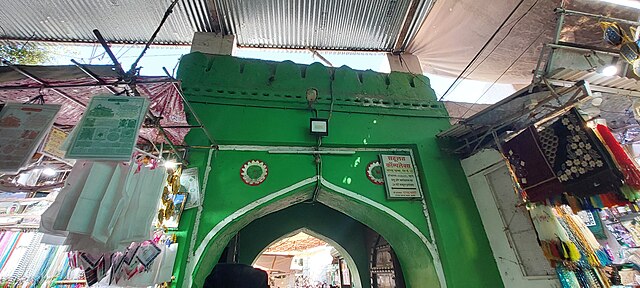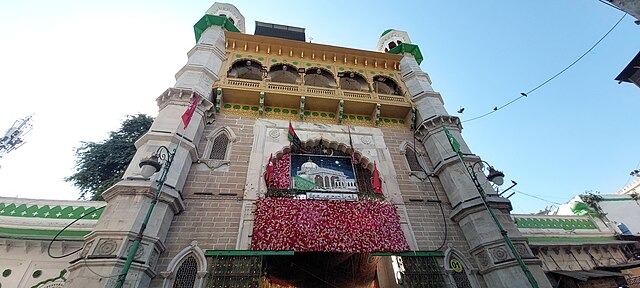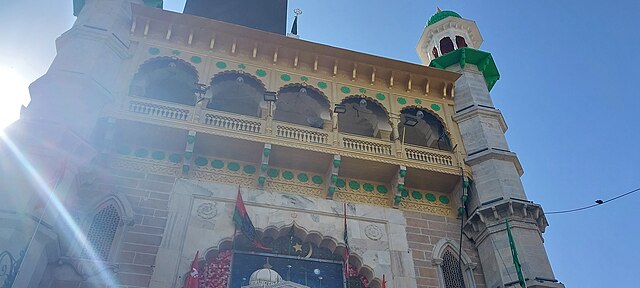Have you ever felt a pull toward a place that hums with spiritual energy? A place where history, faith, and culture weave together like threads in a vibrant tapestry? That’s Ajmer Sharif for you—a sacred Sufi shrine nestled in the heart of Rajasthan, India. Known as the Dargah Sharif or Ajmer Dargah, this is the resting place of Khwaja Moinuddin Chishti, a 13th-century Sufi saint whose teachings of love and compassion still echo through time. Whether you’re a pilgrim seeking solace or a curious traveler chasing stories, Ajmer Sharif offers an experience that’s as profound as it is unforgettable. Let’s dive into what makes this place so special, shall we?
The Legacy of Khwaja Moinuddin Chishti
Picture a man who left behind a life of comfort to spread messages of kindness and unity. That was Khwaja Moinuddin Chishti, fondly called Khwaja Garib Nawaz, or “Patron of the Poor.” Born in 1143 in modern-day Iran, he journeyed to India during the reign of Sultan Iltutmish, settling in Ajmer. Why Ajmer? Some say it was divine guidance; others believe it was his mission to bridge divides in a land of diverse faiths. His teachings, rooted in Sufism—a mystical branch of Islam—emphasized love, tolerance, and devotion to God. His dargah, where he was laid to rest in 1236, became a beacon of hope, drawing millions across centuries.
A Saint for All
What makes Khwaja Moinuddin so extraordinary? It’s his universal appeal. His message wasn’t just for Muslims—it resonated with Hindus, Sikhs, Christians, and anyone seeking spiritual truth. Stories abound of his miracles, like healing the sick or feeding the hungry with a single cauldron of food. These tales, passed down through generations, paint him as a figure of boundless compassion. His philosophy? Love all, serve all. It’s no wonder his shrine is a melting pot of faiths, where people from all walks of life come to pray, reflect, and find peace.
The Ajmer Sharif Dargah: A Sacred Space

Step into the Ajmer Sharif Dargah, and you’ll feel like you’ve walked into a living storybook. Tucked at the foot of Taragarh Hill, just 2 kilometers from Ajmer’s railway station, the dargah is a sprawling complex of courtyards, tombs, and mosques. The air hums with qawwali music, the scent of rose petals, and the quiet murmurs of prayers. It’s not just a place; it’s an experience that wraps you in a warm, spiritual embrace. Up to 20,000 pilgrims visit daily, with numbers swelling during the annual Urs festival. But what exactly makes this place tick?
Architectural Marvels of the Dargah
The dargah isn’t just spiritually rich—it’s a feast for the eyes. The Buland Darwaza (not to be confused with the one in Fatehpur Sikri) stands tall as the main entrance, its white marble gleaming under the Rajasthan sun. Inside, the Jannati Darwaza, a silver gate opened only during special occasions, adds a touch of mystique. The shrine itself, housing the saint’s tomb, is adorned with gold and silver embellishments, while the surrounding courtyards feature structures like the Shahjahani Masjid, built by Emperor Shah Jahan. Every corner tells a story of devotion and history, blending Persian and Indian architectural styles.
The Cauldrons of Generosity
Ever heard of a cauldron so big it could feed thousands? The dargah’s two massive deghs (cauldrons), donated by Emperors Akbar and Jahangir, are used to cook “degh ka khana”—a delicious mix of rice, ghee, nuts, and raisins. These cauldrons, still in use today, symbolize the saint’s legacy of feeding the needy. Watching the food being prepared is like witnessing a ritual of love, with volunteers stirring the steaming mixture as pilgrims gather, eager to partake in this sacred meal.
The Urs Festival: A Celebration of Faith
Imagine a festival so vibrant it feels like the heart of Ajmer beats louder. The Urs, marking the death anniversary of Khwaja Moinuddin, is a six-day extravaganza held in the Islamic month of Rajab. It’s not a somber affair but a joyous celebration of the saint’s union with the divine. Pilgrims from across the globe flock to Ajmer, offering chadars (sacred sheets) and rose petals—up to seven tonnes daily! Qawwali performances fill the air, and the dargah glows with lights and devotion. From political leaders to common folk, everyone joins in, making Urs a testament to the shrine’s universal pull.
Notable Chadar Offerings
Did you know world leaders have been part of this tradition? In 2015, Indian Prime Minister Narendra Modi offered a chadar, a gesture of respect. Back in the day, US President Barack Obama sent a red and green chadar with a message of “deepest friendship” and “peace.” Even Afghan President Ashraf Ghani joined in, sending a chadar from Kabul in 2021. These offerings highlight the dargah’s global significance, a place where diplomacy meets devotion.
Rituals and Offerings at Ajmer Sharif
Visiting Ajmer Sharif is like stepping into a sacred dance of rituals. Pilgrims offer chadars, flowers, and incense, placing them at the saint’s tomb with whispered prayers. Some tie threads at the dargah’s railings, each knot a wish for health, love, or prosperity. The langar, or community kitchen, serves free meals to all, embodying the saint’s spirit of generosity. Ever wondered what it’s like to share a meal with strangers, united by faith? It’s humbling, heartwarming, and quintessentially Ajmer Sharif.
The Role of Qawwali
Close your eyes and let the soulful strains of qawwali wash over you. These devotional songs, performed by skilled qawwals, are a cornerstone of the dargah’s spiritual vibe. Sung in praise of the saint and the divine, qawwali bridges the earthly and the ethereal. The rhythmic claps, soaring vocals, and poetic lyrics can move even the most stoic heart. It’s no surprise that qawwali sessions during Urs draw crowds who sway, clap, and lose themselves in the music.
A Universal Welcome
Here’s something beautiful: the dargah welcomes everyone. Men, women, and children, regardless of faith, can enter and offer prayers. This inclusivity is rare and precious, reflecting the saint’s belief that divinity resides in every heart. Whether you’re tying a thread or simply soaking in the atmosphere, you’ll feel like you belong. Isn’t that what true spirituality is all about?
Ajmer Sharif in Popular Culture

The dargah’s magic has spilled into films and music, too. Indian movies like *Mere Gharib Nawaz* (1973) and *Sultan E Hind* (1973) weave stories around the saint’s life and the dargah’s aura. These films capture the shrine’s role as a place of miracles and unity, where characters find redemption through faith. Even today, Bollywood songs and qawwalis reference Khwaja Moinuddin, keeping his legacy alive in pop culture.
A Photographer’s Paradise
Ever noticed how some places beg to be photographed? After visiting the shrine, pilgrims often head to nearby photo studios, many run by Hindu families who settled in Ajmer during India’s Partition. For as little as ₹20, you can get a professional photo capturing your dargah moment. These snapshots aren’t just keepsakes—they’re a bridge between communities, blending faith and artistry in a frame.
Visiting Ajmer Sharif: Practical Tips
Planning a trip? Ajmer Sharif is easy to reach, just 500 meters from the Central Jail and a short walk from Ajmer Railway Station. The best time to visit is during cooler months (October to March) to avoid Rajasthan’s scorching heat. Dress modestly—think covered shoulders and knees—and remove your shoes before entering the dargah. Guided tours are available, but exploring on your own lets you soak in the vibe at your own pace. Pro tip: Visit early morning or late afternoon to dodge the crowds.
Where to Stay and Eat
Ajmer offers plenty of accommodation options, from budget guesthouses to mid-range hotels. For food, don’t miss local delights like *kadhi kachori* or *samosas* at street stalls near the dargah. If you’re lucky, you might sample the langar’s degh ka khana—trust me, it’s a treat for your soul and stomach!
Respecting the Space
Like any sacred site, Ajmer Sharif thrives on respect. Keep your voice low, avoid photography inside the main shrine, and be mindful of pilgrims praying. A little courtesy goes a long way in preserving the dargah’s sanctity. After all, you’re not just a visitor—you’re part of a centuries-old tradition.
Why Ajmer Sharif Matters Today

In a world often divided by borders and beliefs, Ajmer Sharif stands as a reminder of what unites us. Its legacy of love, tolerance, and service feels more relevant than ever. Whether you’re seeking answers to life’s big questions or simply a moment of peace, the dargah offers a space to reflect and connect. It’s like a lighthouse, guiding lost ships to shore with its timeless wisdom.
A Global Symbol of Unity
From emperors to presidents, the dargah has drawn the powerful and the humble alike. Its ability to bridge cultures and faiths makes it a global symbol of harmony. In an age of instant gratification, the slow, soulful rituals of Ajmer Sharif remind us to pause, breathe, and embrace the human spirit.
Conclusion
Ajmer Sharif isn’t just a destination; it’s a journey into the heart of Sufi spirituality. From the soul-stirring qawwalis to the aroma of rose petals, every moment here feels like a conversation with the divine. Whether you’re drawn by faith, history, or curiosity, the dargah leaves you with a sense of peace that lingers long after you leave. So, next time you’re in Rajasthan, make a stop at Ajmer Sharif. You might just find a piece of your heart you didn’t know was missing. Ready to pack your bags and experience it for yourself?
FAQs About Ajmer Sharif
1. What is the best time to visit Ajmer Sharif?
The ideal time is between October and March when the weather is cooler and more comfortable for exploring. The Urs festival, held in the Islamic month of Rajab, is a vibrant time to visit but expect larger crowds.
2. Can non-Muslims visit the Ajmer Sharif Dargah?
Absolutely! The dargah welcomes people of all faiths. Men and women can enter, and the inclusive atmosphere is one of its defining features.
3. What should I wear when visiting the dargah?
Dress modestly—cover your shoulders and knees. Women may want to carry a scarf to cover their heads as a sign of respect, though it’s not mandatory.
4. What is the significance of the chadar offering?
Offering a chadar (sacred sheet) is a gesture of devotion and respect to Khwaja Moinuddin Chishti. Pilgrims believe it carries their prayers to the saint.
5. Is photography allowed inside the Ajmer Sharif Dargah?
Photography is restricted inside the main shrine to maintain its sanctity. However, you can take photos in the outer courtyards and nearby areas.

